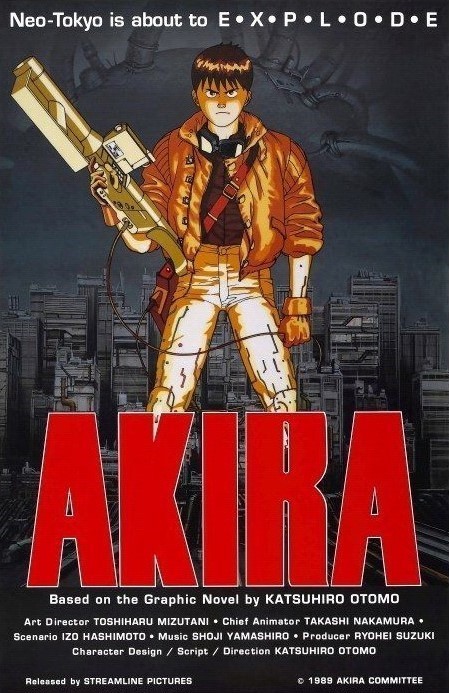 This is the 1988 cyberpunk-themed anime feature that, prior to game-changers like GHOST IN THE SHELL/ Kôkaku kidôtai (1995) and PERFECT BLUE/ Pâfekuto burû (1997), irrevocably altered the format. AKIRA‘s international success was unprecedented in the anime world, and despite some very real shortcomings AKIRA, written and directed by Katsuhiro Ôtomo, remains one of the key anime features.
This is the 1988 cyberpunk-themed anime feature that, prior to game-changers like GHOST IN THE SHELL/ Kôkaku kidôtai (1995) and PERFECT BLUE/ Pâfekuto burû (1997), irrevocably altered the format. AKIRA‘s international success was unprecedented in the anime world, and despite some very real shortcomings AKIRA, written and directed by Katsuhiro Ôtomo, remains one of the key anime features.
It was based on a six volume WAR AND PEACE-length manga, written and illustrated by Ôtomo. That manga was popular enough to be given an English translation by Marvel Comics at a time when the format wasn’t well regarded in the US (it’s said to be one of the first-ever examples of a manga series being translated in its entirety), while this film adaptation, priced at a record $10 million, was so eagerly awaited a “PRODUCTION REPORT” documenting its progress was released to VHS in 1987.
In adapting his manga to a two hour film Ôtomo was forced to greatly pare down the narrative, and make do with the fact that the saga was still incomplete when the film was made (the AKIRA manga wasn’t actually concluded until 1990). Ôtomo also set himself and his animators some real challenges by having the film take place largely at night, requiring extra attention to color and shading, and utilizing computer generated imagery, which in 1988 was largely unheard-of in the anime world.
The setting is Tokyo in the far-off year 2019, 29 years after a never-explained disaster. In this future world, in which (as the American poster tagline trumpets) “Neo-Tokyo is about to E-X-P-L-O-D-E,” terrorist attacks and gang warfare are commonplace occurrences. We’re introduced to Kaneda, a young punk, and his pals, whose ranks include his nerdy friend Tetsuo.
During a nighttime scuffle with a rival cycle gang Tetsuo meets a wrinkly fellow who can cause explosions with a literal flick of his wrist and disappear into thin air. The guy does just that, leaving Tetsuo to be taken away by a band of stern government officials, who place him in an experimental hospital for tests and observation. Tetsuo, however, uses his newfound supernatural abilities to break out. He’s determined to unleash a force known as Akira, a supernaturally-endowed child whose remains are contained in a vault located underneath the Neo-Tokyo Olympic stadium. Tetsuo makes his way to the stadium, followed by government operatives, his Kaneda-led comrades and the wrinkled weirdo who set everything in motion. What ultimately happens I’m not sure.
The story is largely a blur, filled with gaps and detours that go unexplained, and gratuitous (albeit thrilling) action sequences. A perusal of the manga is required for even partial comprehension.
The film, however, nearly makes up for its narrative shortcomings with thematic underpinnings that resonate far beyond mere plot points. Terrorism, political corruption, juvenile delinquency and a deeply uncertain future trajectory were all pressing concerns in the late 1980s (and, needless to add, remain so today). According to publisher Naho Yamada, “Ôtomo jacked into his generation’s frustration with society…and created an epic that, in true Japanese fashion, processed societal trauma through cataclysmic visual symbolism.”
The extraordinary visuals are another undoubted attribute. Eschewing the stylistic and technical elements of most anime, AKIRA utilized a much higher image-to-frame ratio than was standard for animated features of the late eighties, and a very Western-influenced visual palette. Its closest antecedents were BLADE RUNNER, TRON and the films of Alejandro Jodorowsky, which tended to eschew logic and structure in favor of bizarre and audacious imagery.
AKIRA’s trance-inducing images include a giant teddy bear that leaks milk from its every orifice, a “pattern indicator” comprised of CGI that wavers and sprouts electronic tendrils, tail lights that literally bleed onto the screen and a human body expanding until it fills the Olympic stadium where the film’s climax takes place. Most impressive of all, perhaps, is the flashy presentation of a future Tokyo, which can be said to be the film’s true protagonist (even if its details are no longer as futuristic as they once seemed).
The score by Shôji Yamashiro (real name Tsutomi Ōhashi) is another highlight. That score is comprised, surprisingly, of traditional choral and percussive musical elements that on Ôtomo’s insistence were made to function as standalone compositions. The visuals were inspired by the score rather than the other way around, a method that doesn’t always work (see THE KEEP) but did so here. Indeed, it’s fair to say that this is a rare instance when the music is as important to a film’s overall impact as its visuals, with the score literally setting the mood and pace of what registers as a mind scraping viewing experience, even if it doesn’t make much sense.
Vital Statistics
AKIRA
Toho
Director: Katsuhiro Ôtomo
Producers: Shunzo Kato, Ryohei Suzuki
Screenplay: Katsuhiro Ôtomo, Izô Hashimoto
(Based on a manga by Katsuhiro Ôtomo)
Cinematography: Katsuji Misawa
Editing: Takeshi Seyama
Cast: Mitsuo Iwata, Nozomu Sasaki, Mami Koyama, Tesshô Genda, Hiroshi Ôtake, Kôichi Kitamura, Michihiro Ikemizu, Yuriko Fuchizaki, Masaaki Ôkura, Tarô Arakawa, Takeshi Kusao, Kazumi Tanaka, Masayuki Katô, Yôsuke Akimoto, Masato Hirano, Yukimasa Kishino
